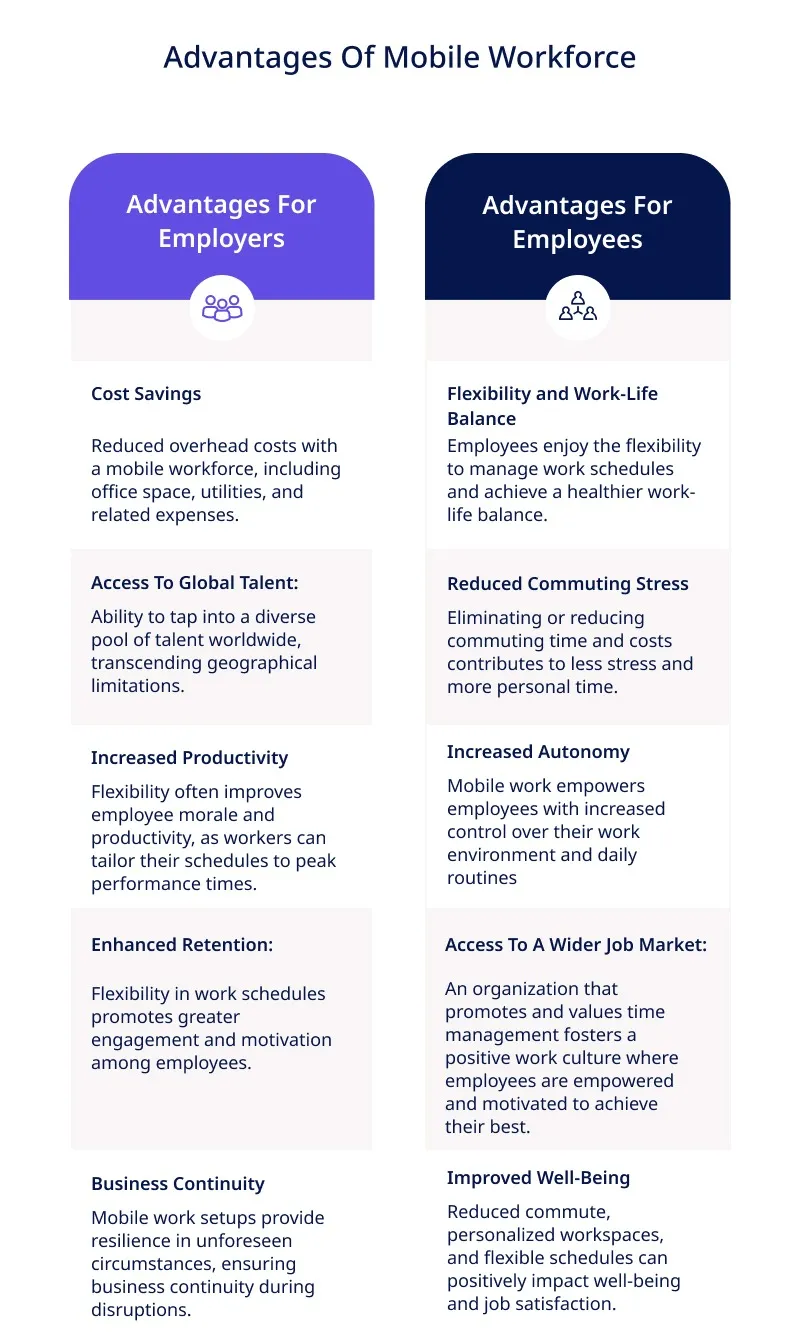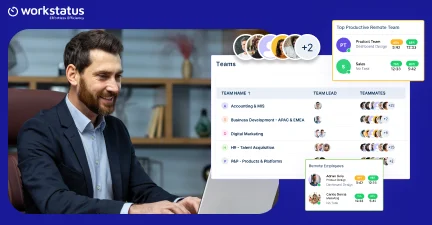Table of Contents
Are you part of the rapidly growing mobile workforce or leading a team navigating the nuances of remote collaboration?
In an era where flexibility and adaptability are paramount, the mobile workforce has become an integral component of modern businesses.
Did You Know?
The United States is poised to witness a significant surge in mobile workers, with projections indicating a rise from 78.5 million in 2020 to an estimated 93.5 million by 2024.
As we enter 2024, the need for effective mobile workforce strategies has never been more crucial. This blog explores five key strategies tailored to elevate your mobile workforce management in the dynamic landscape of 2023.
Current Trends Shaping Mobile Workforce
The global shift towards remote work significantly shapes the workforce landscape. Here are some key statistics and data supporting this trend:
- As of 2023, 12.7% of full-time employees work from home, while 28.2% work in a hybrid model. By 2025, it is estimated that 32.6 million Americans will be working remotely, which equates to about 22% of the workforce.
- A Gallup survey found that 8 in 10 people work in a hybrid or remote model, while only 2 in 10 are entirely on-site. The hybrid work model is expected to grow from 42% in 2021 to 81% in 2024.
- 54% of companies said the shift toward mobile work has increased employee productivity. Mobile work enables businesses to offer more competitive compensation and benefits packages due to increased employee productivity and access to global talent.
These statistics and trends underscore the widespread acceptance and growing prevalence of remote work, driven by the evolution of digital tools, changing work norms, and the increasing reliance on mobile technology.
Role Of Cutting-Edge Tech In Facilitating Mobile Work
Next-Gen Collaboration Platforms:
AI-infused tools redefine remote teamwork, offering real-time collaboration, virtual whiteboards, and intelligent integrations for a seamless work experience.
Immersive VR and AR:
Virtual and augmented reality technologies create an interactive virtual workspace, fostering engagement and connection in remote teams.
Fortified Cybersecurity:
Biometric authentication, zero-trust frameworks, and encrypted channels provide robust security solutions for safeguarding sensitive data in decentralized work environments.
Smart IoT Workspaces:
IoT devices optimize remote work with smart home offices and sensors, enhancing productivity and well-being for mobile workers.
AI-Driven Automation:
Artificial intelligence automates routine tasks, empowering teams to focus on strategic work, from data analysis to using AI chatbots for enhanced efficiency.
How Employee Expectations Have Evolved With Time?
Shift In Work-Life Balance:
Modern employees seek a healthier work-life balance, valuing flexibility and the ability to blend professional and personal commitments. The traditional 9-to-5 model is evolving into more flexible schedules and remote work options.
Emphasis On Purpose And Values:
Beyond a paycheck, employees now prioritize working for organizations that align with their values and contribute to a sense of purpose.
Companies that are committed to social responsibility and sustainability attract and retain talent.
Focus On Professional Development:
Continuous learning is no longer a luxury but an expectation. Employees now value employers who invest in their professional development, providing opportunities for upskilling, training, and career growth.
Demand For Inclusive Work Cultures:
Diversity, equity, and inclusion are no longer buzzwords but fundamental expectations. Employees seek workplaces that embrace diversity, foster inclusion, and provide equal opportunities for all.
Digital Connectivity and Collaboration:
With the rise of digital natives in the workforce, there is a growing expectation for seamless digital communication and collaboration tools.
Employees anticipate modern technology that enhances productivity and facilitates practical remote work.

Strategies To Conquer Challenges In The Mobile Workforce
Challenge: Ensuring Efficient Remote Work Management
As organizations embrace remote work, tracking the whereabouts of a mobile workforce can pose challenges in terms of efficiency, transparency, and accountability.
The lack of visibility into employees’ locations may hinder optimal performance and effective management.
Strategy 1: Opting For GPS Tracking Software
To address the challenge of efficient remote work management, implementing GPS tracking solutions offers a comprehensive solution:
- Real-Time Location Insights:
Gain immediate visibility into the current location of remote workers, facilitating proactive decision-making and resource allocation.
- Optimized Work Routes:
Empower employees to choose the most time-efficient routes for their tasks, reducing unnecessary travel time and enhancing overall productivity.
- Accountability & Performance Monitoring:
Establish a culture of accountability by leveraging GPS technology to monitor work-related movements, ensuring that employees remain focused and aligned with organizational goals.
- Geofencing For Work Zones:
Implement geofencing to define specific work zones, triggering notifications or tasks when employees enter or leave designated areas.
Challenge: Ensuring Accountability
Traditional attendance systems may need to improve in ensuring accurate tracking, especially in remote settings. Verifying the identity of remote workers and maintaining attendance transparency becomes a significant challenge.
Strategy 2: Selecting Attendance Management With Selfie Validation
To overcome attendance-related challenges and reinforce accountability in remote work scenarios, adopting attendance management with selfie validation proves to be a robust strategy:
- Facial Recognition Technology:
Implement advanced facial recognition technology to ensure secure and accurate attendance tracking, minimizing the risk of errors or inaccuracies.
- Real-Time Validation:
Integrate real-time validation through selfie verification, enhancing the accuracy and reliability of attendance records.
- Enhanced Security Measures:
Strengthen attendance systems with additional layers of security, incorporating biometric authentication to prevent unauthorized access or attendance manipulation.
- Detailed Attendance Reports:
Generate detailed attendance reports that include verified selfies, providing a comprehensive overview for HR and management.
Challenge: Ensuring Complete Transparency
It can be challenging for organizations to gauge the productivity levels of remote employees without direct supervision. The lack of visibility into daily activities and work progress hinders effective performance monitoring and optimization.
Strategy 3: Incorporating Employee Activity Tracking
Implementing employee activity tracking addresses these challenges and contributes significantly to enhancing productivity:
- Insightful Performance Metrics:
It provides detailed insights into employees’ daily activities, enabling managers to evaluate performance based on tangible data rather than assumptions.
- Identification Of Efficiency Gaps:
By monitoring activities, organizations can identify bottlenecks or areas where efficiency can be improved, fostering continuous process optimization.
- Data-Driven Decision-Making:
Organizations can make informed decisions based on collected data, leading to more strategic resource allocation and workflow improvements.
- Individual and Team Productivity Benchmarks:
Employee activity tracking allows for establishing benchmarks for individual and team productivity, aiding in goal-setting and performance improvement.
Challenge: Streamlining Workforce Management
Managing a dispersed workforce efficiently becomes a logistical challenge as remote work becomes prevalent. With a centralized hub for oversight, organizations may maintain a cohesive and coordinated approach to workforce management.
Strategy 4: Navigate Through Central Dashboard
The implementation of a centralized dashboard offers a comprehensive solution, streamlining workforce management and fostering organizational cohesion:
- Real-Time Workforce Overview:
A central dashboard provides real-time insights into the status of various tasks, projects, and team members, facilitating immediate awareness and decision-making.
- Task Prioritization and Resource Allocation:
Managers can prioritize tasks and allocate resources efficiently by having a unified view of ongoing projects and workloads.
- Enhanced Communication and Collaboration:
A centralized hub encourages seamless communication and collaboration among team members, mitigating the challenges associated with siloed information.
- Customizable Reporting:
The central dashboard allows for customizable reporting, tailoring insights to the specific needs of different departments or projects within the organization.
Challenge: Data-Driven Decision-Making
Organizations need help to extract meaningful insights from the vast amount of data generated in a mobile workforce environment.
Traditional reporting methods may need to provide more in-depth analysis for informed decision-making.
Strategy 5: Data-Driven Decision With AI-Powered Reports –
Implementing AI-powered reports not only overcomes data-related challenges but also empowers organizations with transformative benefits:
- Insightful Data Analysis:
It utilizes artificial intelligence to analyze vast datasets, extracting meaningful patterns and trends that might go unnoticed with manual analysis.
- Predictive Analytics:
AI-powered reports can offer predictive insights, allowing organizations to anticipate future trends, challenges, and opportunities, fostering a proactive approach to decision-making.
- Customized Reporting Dashboards:
Organizations can tailor reporting dashboards to specific key performance indicators (KPIs) or metrics, providing a customized view that aligns with their strategic goals.
- Efficient Resource Allocation:
Organizations can allocate resources more efficiently by understanding resource utilization and performance metrics and optimizing human and technological assets.
- Strategic Planning:
AI-driven insights empower organizations to make strategic decisions, supporting long-term planning and aligning business strategies with evolving market dynamics.
These AI-powered reports streamline data analysis and elevate decision-making capabilities, positioning organizations for agility and success in the ever-evolving landscape of mobile workforce management.
Predictions For Mobile Workforce Trends Beyond 2024
Green Initiatives In Remote Work Practices:
Organizations will embrace eco-friendly practices in remote work, contributing to sustainability goals by reducing carbon footprints associated with traditional office spaces.
Increased Focus On Cybersecurity for Remote Work:
With the growing reliance on remote work, there will be a heightened emphasis on enhancing cybersecurity measures to protect sensitive data and ensure secure communication channels.
Continuous Integration Of Wellness Technologies:
Wellness technologies like wearables and health monitoring apps will become more integrated into remote work practices, promoting a holistic approach to employee well-being.
Conclusion
As we navigate the dynamic landscape of mobile workforce strategies and anticipate trends beyond 2024, one thing remains clear: adaptability is key.
Embracing technological advancements, fostering well-being, and staying attuned to the evolving needs of both employers and employees will define success in the future of work.
To stay ahead, consider leveraging tools like Workstatus for comprehensive workforce management.
Discover the power of seamless collaboration, real-time insights, and enhanced productivity. Embrace the future with Workstatus – where efficiency meets innovation.
FAQs
Q1: What is GPS tracking, and how does it benefit remote work?
A1: GPS tracking utilizes location-based technology to monitor and manage the movements of remote workers. It enhances efficiency by providing real-time insights, optimizing routes, and ensuring accountability.
Q2: Is Workstatus suitable for businesses of all sizes?
A2: Yes, Workstatus is scalable and designed to cater to the needs of businesses of all sizes. Whether you are a small startup or a large enterprise, Workstatus offers customizable solutions to streamline workforce management.
Q3: What customer support options are available with Workstatus?
A3: Workstatus provides customer support through various channels, including online chat, email, and phone support. Our dedicated support team can assist you with any queries or concerns.












